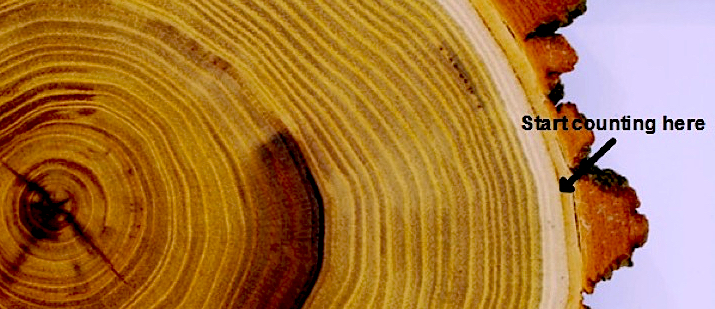Exploration
Dendrochronology is the study of tree rings and dating trees and/or other samples of wood. Students will practice their dendrochronology skills by analyzing a tree cross-section image and the types of wood produced by trees that compose the growth rings. Connections between seasonal conditions and types of wood will be reinforced and applied by students in this activity. This activity requires students to work at a computer station.
.jpg)
Photo of Ponderosa Pine illustrating years of diminished growth due to Pandora Moth defoliation (white arrow and bracket). Photo Credit: Photo © James H. Speer, Indiana State University.
Objectives
Students will:
- Be able to date a tree using a cross-section image to practice counting rings.
- Describe which type of cells become the “wood” of a tree and which type of cells become the bark of the tree.
- Describe the types of wood produced by trees depending upon seasonal conditions.
Lesson Materials
Computers or computer workstations
Tree Ring Concept Map Worksheet
Procedures
Explore:
- Have students practice counting tree rings using the image below (click image to download file).
 Photo credit: Cherry tree cross section. Shelby Sawyers, Northwest Middle School, Carroll County Public Schools.
Photo credit: Cherry tree cross section. Shelby Sawyers, Northwest Middle School, Carroll County Public Schools.
This tree fell in February of 2014. Count the rings until you find the ring that corresponds to the year you were born. Make a note of any other important events in your life and the year.
2. Hand out the Tree Ring Concept Map Worksheet.
3. Go to the University of Arizona Laboratory of Tree Ring Research website to help complete the Tree Ring Concept Map Worksheet.
Explain:
Discuss student responses and give students the opportunity to explain in their own words how environmental conditions and tree rings are related.
Example:
Warm Temperatures + Plenty of Rainfall = ____ Rings.
Warm Temperatures + Plenty of Rainfall = Wide Rings.
The combination of warm temperatures and plenty of rainfall gives trees the opportunity to produce more wood.
Evaluate:
The explanation activity above also serves as a formative assessment that illustrates how students are connecting ideas on the concept map and the impact on the tree.
Standards
Accessing web site, examining the width of tree rings
References
Tree Ring Background, University of Arizona, http://ltrr.arizona.edu/about/treerings
A New Generation of American Chestnut Trees May Redefine America's Forest by F. Jabr. Scientific American Vol. 310, Issue 3, Web Exclusives.
.jpg)




